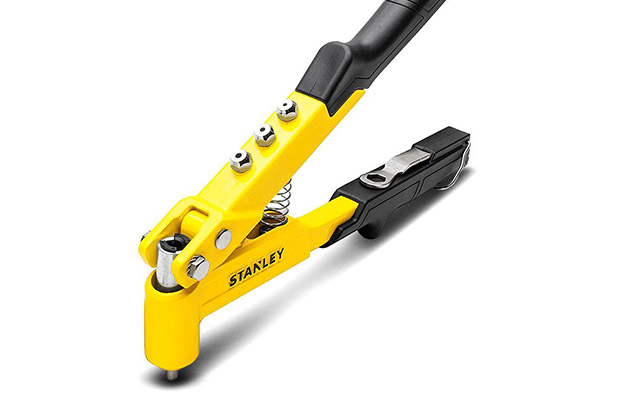If you like doing DIY, there is a good chance that you first learned about pop rivet guns in industrial arts class in high school. A rivet requires a tool that pulls the mandrel away from the installation surface while maintaining the rivet’s hat firmly pressed against the surface.
The first step in knowing rivet guns is to comprehend how a rivet tool functions. Here are a few straightforward instructions to help you manage this new tool if you have never used a pop rivet tool.
Table of Contents
Types Of Rivet Guns
- Hand Rivet Gun
- Heavy Duty Lever Riveter
- Cordless Battery Riveting Tool
- Pneumatic Rivet Gun
Although not all rivet guns are created equal, it is simple to determine which kind is required for a given application. Read on as we discuss the advantages and disadvantages of each kind of riveter.
How Do Pop River Guns Operate?
The pop rivet itself is a tiny fastener that fits into the throat of a pop rivet gun. It is typically made of aluminum and has a malleable head and a steel stem. Once the flange is flush against the front side of the workpiece, you simply squeeze the tool handles together. The fastener head is fed into a guide hole through both mating parts. The “rivet” is compressed and widened as a result of being drawn up against the backside with each squeeze. The round flange is on the front side, and on the back is a crumpled-up mass of malleable aluminum that serves as a nut after the stem separates from the head after a few squeezes. Although they are not always attractive and do protrude slightly, the connection is very strong.
Steps To Using A Rivet Tool
Step 1: Prepare
Put on your protective gloves and eyewear before continuing. Light metal rivets have a tendency to break, so it is wise to take all necessary precautions. The metal sheets should then be laid out. These can have small holes already drilled into them or you can use a drill to make them. In order to fit the rivet, place two sheets of metal side by side with the holes overlapped.
Step 2: Load The Rivet
With one hand holding your rivet, depress the trigger to release the holding arms. As far as you can, insert the metal rivet into the tool so that it rests on a chuck at the back of the gun. The head of your rivet should be extended between the teeth, with the pin facing the gun’s rear. So that the rivet can be secured, let go of the trigger.
Step 3: Install The Rivet
Insert the rivet’s head through the metal sheets’ holes. Check to see if the rivet passes through both metal sheets at once and is not obstructed from underneath. As soon as you encounter resistance, press down and pull the rivet gun handle. Pulling the handle once more after releasing it will ensure that the tool is securely fastened to the rivet’s top. Repetition is necessary until the gun’s end starts to pop. This is the pin breaking, and it shows that the rivet is fastened to the metal sheets.
Step 4: Finish
When the pin snaps, the manual pop rivet gun will release the rivet from the hole. When you turn the tool around, the pin will come out. Then, you can either choose to smooth down your rivet to remove any sharp edges created when the pin broke away, or you can fit another pop rivet exactly the same way. Before attempting to rivet another section of the sheet, make sure the metal sheets are joined and that the rivet is secure.
Read More: How To Use A Balloon Tier?
Advantages And Drawbacks Of Rivet Tool
Advantages include:
- Being cost-effective
- Allowing for the joining of parts when there is limited rear access
- Being durable
- Being lighter than bolts/screws (dependent on rivet material)
Drawbacks include:
- Being difficult to remove once placed
- Protruding from the sheet metal surface, potentially creating a hazard and reducing aerodynamics
- Potential corrosion issues if the rivet material differs from the metal parts to be joined
What Can I Do With Pop Rivets?
Around the house, pop rivets can be used for a variety of tasks:
Ductwork. Examine your basement’s network of heat and cold air vents. Think about wanting to patch a broken seam or even attach something to the metal. You should use a pop rivet gun.
Craft projects. Pop rivets are one of the few ways to mechanically join two flat sheets of acrylic or attach metallic hardware to transparent materials like acrylic. If you visit craft and DIY websites, you may occasionally see some cool projects you can build using pop rivets as the main fasteners. Usually, these involve attaching metal hardware to other metal surfaces.
Repair. Consider that one of the metal panels on your desk has come loose from the frame. A metal screw will likely strip out if you attempt to simply screw it back on, and this frequently occurs. You can try a nut and bolt, but you may have trouble getting your fingers or a tool inside to hold the nut while you tighten the bolt in many situations. Who wants to weld, even though it can be done? Your issue can be resolved with a single pop rivet, which also creates a rather elegant rivet flange that looks much more professional and deliberate than a large bolt head. Also hidden from view is the ugly side.
Read Next: How To Make Tool Little Alchemy?


